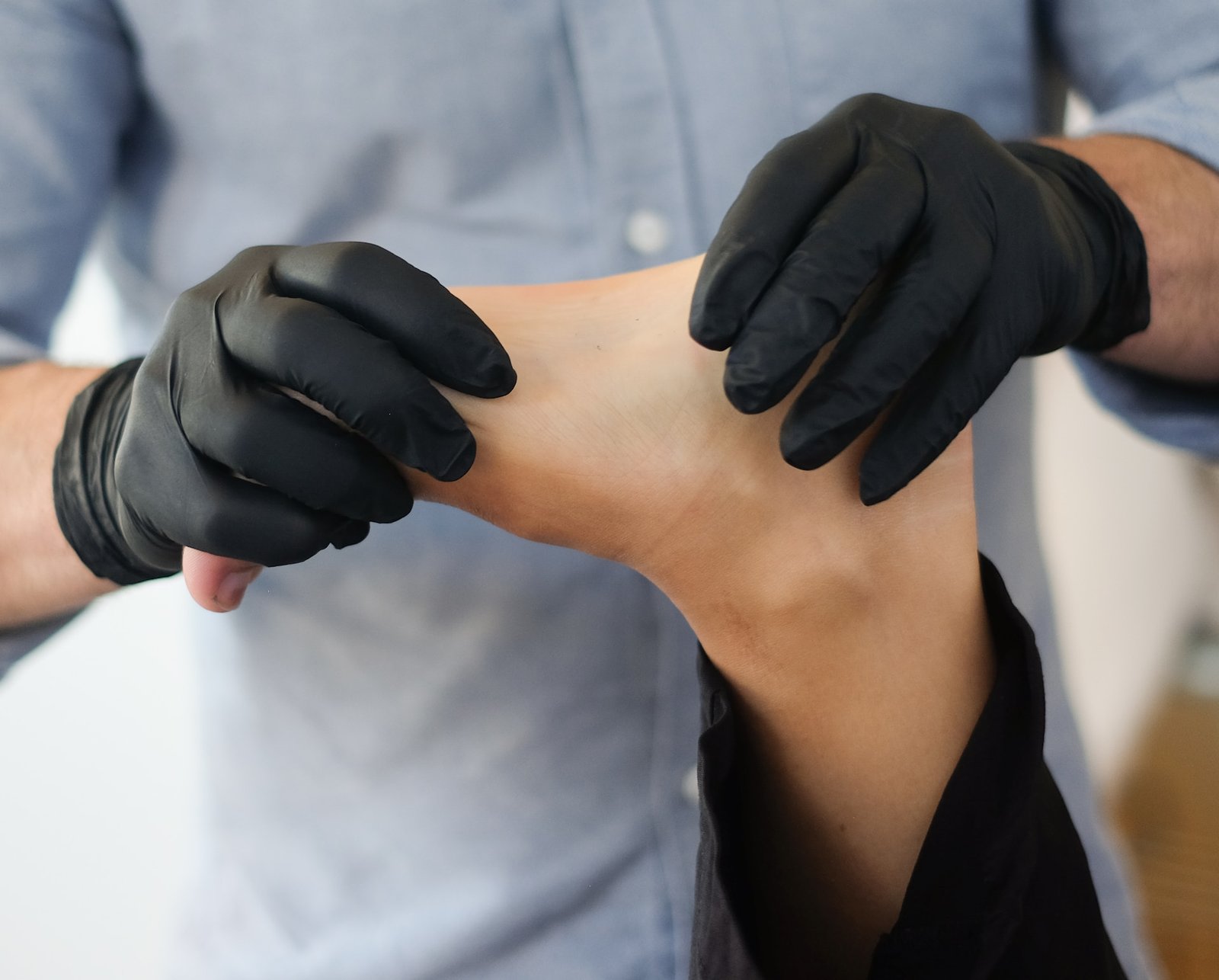Every step sends a sharp, stabbing pain through your heel, turning what should be a simple morning walk into a challenging ordeal. This is a daily reality for those suffering from plantar fasciitis, a common but debilitating foot condition. Imagine finding relief and returning to those cherished morning walks without pain. This article explores plantar fasciitis medication treatment.

Key Takeaways
- Plantar fasciitis is a common foot condition that causes heel pain and can be treated various medications.
- Over-the-counter medications, such as NSAIDs and analgesics, can be effective in managing pain and inflammation associated with plantar fasciitis.
- Advanced pharmacologic therapies, including corticosteroid injections and platelet-rich plasma (PRP) injections, may be recommended for severe cases of plantar fasciitis.
- Exercise and stretching, particularly of the calf muscles and Achilles tendon, are important in the initial treatment of plantar fasciitis.
- Alternative treatment options like orthotic devices, physical therapy, and proper footwear can also play a role in treating plantar fasciitis.
Understanding Plantar Fasciitis
Plantar fasciitis is a common condition characterized by inflammation of the plantar fascia, the band of tissue that connects the heel bone to the toes. This leads to heel pain, especially during the first steps in the morning or after periods of rest. The Achilles tendon and lower leg muscles play a crucial role in this condition.
Symptoms of plantar fasciitis, also known as plantar heel pain, include chronic heel pain that can be debilitating if left untreated. Understanding the biomechanical risk factors and proper diagnosis is essential for effective treatment of plantar heel pain.

Risk Factors and Diagnosis
Risk factors for plantar fasciitis include activities that place repetitive stress on the heel bone and surrounding tissue, like long-distance running or ballet dancing. Individuals with flat feet or high arches are more prone to developing this condition. Additionally, tight calf muscles or Achilles tendons can contribute to the strain on the plantar fascia.
Diagnosing plantar fasciitis involves a physical exam to assess the tenderness in the bottom of the foot. Imaging tests like X-rays may be used to rule out other potential causes of heel pain, such as a broken bone or stress fracture. Consulting a healthcare provider is key for accurate diagnosis of plantar fasciitis, as it may be easily mistaken for other conditions such as a stress fracture, and for tailored treatment.
Initial Treatment Strategies
Initial treatment strategies for plantar fasciitis predominantly focus on non-invasive methods to alleviate pain and promote healing. These may include incorporating home remedies like ice packs, ice baths, stretching exercises, and massaging the affected area with ice to reduce inflammation and enhance flexibility.
Lifestyle adjustments such as wearing supportive footwear and using orthotic devices can also play a key role in relieving symptoms. Additionally, engaging in specific exercises targeting the plantar fascia and lower leg muscles under the guidance of a physical therapist can aid in strengthening the affected area and promoting better foot health.
Home Remedies and Lifestyle Adjustments
When dealing with plantar fasciitis, incorporating home remedies and lifestyle adjustments can be beneficial. Simple practices like rest, icing, and gentle stretching can aid in relieving painful heel. Night splints can help maintain the foot’s position during sleep, reducing morning pain. Ensuring proper footwear and avoiding barefoot walking can also support the plantar fascia.
Lifestyle adjustments such as maintaining a healthy weight and avoiding high-impact activities can reduce strain on the heel bone. These home remedies and lifestyle changes, along with medication treatments, can complement other treatment options for managing plantar fasciitis effectively.

The Role of Exercise and Stretching
Physical therapy involving specific exercises and stretching plays a crucial role in managing plantar fasciitis. These targeted interventions help to strengthen the muscles supporting the plantar fascia and improve overall flexibility, reducing strain on the heel bone.
Exercise routines prescribed by a physical therapist often focus on the Achilles tendon and lower leg muscles to alleviate pressure on the plantar fascia. Regular stretching of the calf muscles and plantar fascia itself aids in preventing stiffness, especially common in the morning. Incorporating these activities into your daily routine can significantly contribute to the recovery process.
Over-the-Counter Medication for Plantar Fasciitis
Plantar fasciiitis medication treatment includes over-the-counter medication for plantar fasciitis. OTC medications are readily accessible and provide relief from pain and inflammation. Nonsteroidal anti-inflammatory drugs (NSAIDs) such as ibuprofen and naproxen sodium are commonly used to alleviate discomfort and reduce swelling in the plantar fascia. Additionally, analgesics like acetaminophen can help manage pain associated with this condition.
These medications are often the initial pharmacologic approach in treating plantar fasciitis due to their effectiveness in addressing symptoms. It is essential to follow recommended dosages and consult a healthcare provider if symptoms persist or worsen.
NSAIDs for Pain and Inflammation
NSAIDs, or nonsteroidal anti-inflammatory drugs, are commonly used to alleviate pain and reduce inflammation in plantar fasciitis. These medications can help manage the discomfort associated with this condition by targeting the inflammatory response in the plantar fascia. By inhibiting the production of prostaglandins, NSAIDs effectively relieve symptoms such as heel pain.
It is important to follow the prescribed dosage and duration as directed by a healthcare professional to maximize the benefits of NSAIDs in plantar fasciitis medication treatment. Always consult your healthcare provider before starting any new medication regimen.

Analgesics for Pain Management
For managing the pain associated with plantar fasciitis, analgesics play a crucial role. These plantar fasciitis medication treatments help alleviate discomfort and enable individuals to engage in daily activities more comfortably. Unlike NSAIDs that primarily target inflammation, analgesics focus on pain relief without reducing inflammation.
Common analgesics include acetaminophen, which can be effective for reducing mild to moderate pain. It is essential to follow the recommended dosage and consult a healthcare provider before starting any new medication regimen to ensure safe and effective pain management.
Advanced Pharmacologic Therapies
Corticosteroid injections and Platelet-Rich Plasma (PRP) injections are advanced pharmacologic therapies used for severe cases of plantar fasciitis. Corticosteroids help reduce inflammation of the plantar fascia, providing relief from pain and discomfort. PRP injections involve using the patient’s own blood to promote healing in the damaged tissue. Both treatments are usually administered under the supervision of a healthcare professional experienced in managing foot and ankle conditions.
These therapies may be considered when conservative treatments have not provided adequate relief or for chronic plantar fasciitis cases that require more intensive intervention.
Corticosteroids Injections
Corticosteroid injections, also known as cortisone injections, are a common medical intervention for plantar fasciitis. By directly targeting inflammation in the plantar fascia, corticosteroids can provide significant pain relief. These injections are usually performed by a healthcare professional, such as a sports medicine specialist or a podiatrist.
Corticosteroids work by reducing swelling and alleviating discomfort in the heel area. It’s crucial to follow your healthcare provider’s guidance regarding the frequency and dosage of corticosteroid injections, also known as cortisone injections, to optimize their effectiveness in managing plantar fasciitis symptoms.
Always consult with a healthcare professional before undergoing any injection therapy, such as cortisone injections, for plantar fasciitis.
Platelet-Rich Plasma (PRP) Injections
Platelet-rich plasma (PRP) injections are a regenerative treatment option for plantar fasciitis. By using the patient’s own blood components rich in growth factors, PRP aims to promote healing in the damaged plantar fascia. The procedure involves drawing blood, centrifuging it to isolate the plasma with a high concentration of platelets, and then injecting this PRP directly into the affected area using sound waves to increase blood flow.
PRP injections have shown promising results in accelerating tissue repair and reducing inflammation in some cases of chronic plantar fasciitis, offering a potential alternative for those seeking non-surgical interventions.

Alternative Treatment Options
When exploring alternative treatment options for plantar fasciitis, consider the efficacy of orthotic devices like shoe inserts and custom orthotics. Physical therapy approaches can also provide significant relief by targeting lower leg muscles and the plantar fascia. Additionally, extracorporeal shock wave therapy and dry needling may be beneficial in managing chronic plantar fasciitis symptoms.
For those looking for non-invasive interventions, conservative treatments such as laser therapy or botulinum toxin injections could be worth considering. These alternative approaches offer promising avenues for addressing plantar fasciitis from multiple angles.
Orthotic Devices and Support
Orthotic devices and support play a crucial role in managing plantar fasciitis. They provide necessary cushioning and stability to alleviate pressure on the plantar fascia. Custom orthotics are tailored to individual needs, offering personalized comfort and correction. In contrast, over-the-counter insoles are more generic but still effective for mild cases.
These devices help redistribute weight and support the arch, aiding in natural foot movement. By aligning the foot properly, orthotic solutions promote healing and prevent further strain, making them valuable additions to the treatment regimen.
One important factor to consider when using orthotics for plantar fasciitis is the need to control over-pronation and metatarsal head motion, especially of the first metatarsal head. This can be achieved through semi-rigid, three-quarters to full-length orthotics with longitudinal arch support and by limiting excessive metatarsal head motion.
Physical Therapy Approaches
Physical therapy plays a pivotal role in the comprehensive treatment of plantar fasciitis. A skilled physical therapist can design a personalized plan to alleviate symptoms and address the root cause of the condition. Through targeted exercises and stretches, they aim to strengthen the plantar fascia and surrounding muscles, improve flexibility, and correct any biomechanical issues that may contribute to the problem.
Additionally, physical therapy facilitates proper gait mechanics and helps prevent recurrence by enhancing foot function and overall lower limb alignment. This non-invasive approach is a cornerstone in managing plantar fasciitis effectively.

The Importance of Proper Footwear
Choosing appropriate footwear is crucial in the treatment of plantar fasciitis. Supportive shoes with cushioned soles and good arch support, including longitudinal arch support, can alleviate pressure on the plantar fascia, reducing pain and inflammation. Shoes designed specifically for plantar fasciitis or orthotic inserts can also help correct foot mechanics and distribute weight more evenly.
For individuals with flat feet, motion control shoes or shoes with better longitudinal arch support may decrease the pain associated with long periods of walking or standing. Avoid high heels or flat shoes that offer minimal support, as they can exacerbate symptoms.
Proper footwear plays a significant role in providing comfort and stability for your feet, aiding in the recovery process and preventing further strain on the plantar fascia.
Shoes That Help with Plantar Fasciitis
Footwear plays a crucial role in managing plantar fasciitis. The right shoes can provide adequate support and cushioning to alleviate symptoms. Look for shoes with good arch support and cushioning, particularly in the heel area. Opt for footwear that allows for proper alignment and reduces excessive strain on the plantar fascia.
Consider shoes designed specifically for plantar fasciitis, which may feature attributes like extra cushioning, reinforced arch support, and shock absorption properties. Prioritize comfort and functionality over style when selecting shoes to aid in your plantar fasciitis treatment regimen.
Custom Orthotics vs. Over-the-Counter Insoles
When considering custom orthotics vs. over-the-counter insoles for plantar fasciitis, the key lies in individualized support. Custom orthotics are specially crafted to address specific foot mechanics and provide tailored cushioning. They are effective for severe cases or underlying biomechanical issues.
On the other hand, over-the-counter insoles offer a more cost-effective and readily available solution for mild to moderate plantar fasciitis. While they provide general support, they may not address nuanced foot conditions as effectively as custom orthotics.
Understanding your unique foot needs and consulting a healthcare professional can guide you in choosing the best option for your plantar fasciitis treatment.

Surgical and Non-Surgical Interventions
With severe cases of plantar fasciitis, surgical and non-surgical interventions come into consideration. Surgery, such as plantar fasciotomy, may be an option for chronic conditions resistant to conservative treatments. Non-surgical approaches include shock wave therapy, dry needling, and corticosteroid injections.
Extracorporeal shock wave therapy is a popular non-invasive option that stimulates healing. Physical therapy modalities like laser therapy and botulinum toxin injections can also aid in recovery. Understanding when to transition to surgical interventions is crucial for long-term heel pain management.
When to Consider Surgery
In cases of persistent and severe plantar fasciitis that do not respond to conservative treatments, surgery may be considered as a last resort. If symptoms like chronic heel pain and inflammation significantly affect daily activities, or if there is a risk of long-term damage to the plantar fascia, surgical intervention could be necessary.
Your healthcare provider, possibly in consultation with a foot and ankle specialist, will assess your condition, medical history, and the efficacy of prior treatments to determine if surgery is the most appropriate next step in managing your plantar fasciitis and severe pain.
In some cases, surgery may be the only option to provide relief from severe pain and improve overall function.
Non-Surgical Treatments Worth Exploring
Non-surgical treatments offer viable options for addressing plantar fasciitis. Physical therapy, including specific exercises to strengthen the plantar fascia and lower leg muscles, can improve symptoms. Additionally, employing night splints or shoe inserts relieves pressure and aids healing.
Techniques like dry needling and extracorporeal shockwave therapy have shown effectiveness in reducing pain and inflammation.
Lifestyle modifications, such as calf stretches and wearing supportive footwear, can also contribute to recovery. These non-invasive approaches provide valuable alternatives for individuals seeking relief from plantar fasciitis without opting for surgery.

Preventing Plantar Fasciitis Recurrence
To prevent plantar fasciitis recurrence, maintaining a daily foot care routine is crucial. Engage in specific exercises to strengthen the plantar fascia and surrounding muscles regularly. This can include calf stretches and towel curls to improve flexibility and strength. Additionally, paying attention to proper footwear is essential.
Opt for shoes that provide good arch support and cushioning to reduce impact on the plantar fascia.
Avoid activities that exacerbate symptoms and gradually increase intensity to prevent overloading the plantar fascia, reducing the risk of recurrence significantly. Adopting these preventive measures can aid in long-term management and recovery.
Daily Foot Care Routine
To ensure optimal foot health and manage plantar fasciitis effectively, establishing a daily foot care routine is paramount. Start your day with gentle calf stretches and toe taps to promote flexibility and circulation.
Throughout the day, wear supportive footwear with proper arch and heel cushioning. After activities, a brief ice massage with ice water can help alleviate discomfort and reduce inflammation.
Before bedtime, consider using a night splint to maintain the foot’s position and prevent morning pain. Consistency is key in managing plantar fasciitis, making these simple daily practices, including ice water massage, essential for long-term foot health.
Exercises to Strengthen the Plantar Fascia
Engaging in specific exercises can effectively strengthen the plantar fascia and aid in the recovery from plantar fasciitis. Stretching exercises for the Achilles tendon and calf muscles can relieve tension on the plantar fascia. Towel curls, toe taps, and calf stretches are beneficial for enhancing flexibility and reducing strain on the foot.
Additionally, exercises such as picking up marbles and coins with the toes and towel curls, where the patient sits with the foot flat on the end of a towel placed on a smooth surface, can help strengthen the plantar fascia. Incorporating these exercises into your daily routine at the end of a towel can promote healing and prevent future discomfort associated with plantar fasciitis.

What is the Best Over-the-Counter Medicine for Plantar Fasciitis?
For plantar fasciitis, common over-the-counter medications like ibuprofen and acetaminophen can help manage pain and inflammation. These are easily accessible options before considering prescription drugs. Other remedies include topical creams for localized relief.
How Long Should I Try Home Remedies Before Seeing a Doctor?
It’s recommended to try home remedies for plantar fasciitis for about 4-6 weeks before considering a doctor visit if symptoms persist. If pain or discomfort worsens, seeking medical advice promptly is advised.
Can Plantar Fasciitis Be Cured Without Surgery?
Yes, plantar fasciitis can often be cured without surgery through a combination of treatments such as physical therapy, orthotic devices, proper footwear, and lifestyle adjustments. Surgery is typically considered only when conservative methods fail to provide relief.
What Are the Long-Term Effects of Untreated Plantar Fasciitis?
Ignoring plantar fasciitis can lead to chronic heel pain, altered walking gait, and even foot deformities. Untreated cases may result in severe discomfort, affecting daily activities. It’s crucial to address symptoms promptly to prevent long-term complications.
How Often Should I Change My Orthotics?
Orthotics typically need replacement every 1-5 years, but this can vary based on wear and tear, lifestyle, and changes in foot structure. Regular assessment by a healthcare professional can determine the ideal timeframe for replacing orthotics.
Are Corticosteroid Injections Safe for Treating Plantar Fasciitis?
Corticosteroid injections can be effective in managing plantar fasciitis; however, they come with potential risks such as tissue damage and heel pad atrophy. Consult a healthcare provider for a thorough evaluation to determine if this treatment option is suitable.
What Lifestyle Changes Can Help Manage Plantar Fasciitis Symptoms?
Lifestyle changes like wearing supportive shoes, avoiding high-impact activities, maintaining a healthy weight, and doing stretching exercises can aid in managing plantar fasciitis symptoms effectively. These adjustments help reduce strain on the feet and promote healing.

Conclusion – Plantar Fasciitis Medication Treatment
Choosing the right plantar fasciitis medication treatment, whether OTC, prescription, or herbal, requires careful consideration of the specifics of your condition and lifestyle. Consulting with healthcare professionals and reviewing reliable resources like theheelgp.com can provide invaluable guidance in your journey towards recovery. As you weigh your options, consider what steps you can take today to move towards a pain-free life.
Are you ready to take the first step towards managing your plantar fasciitis pain?
I hope you found this blog helpful and please feel free to comment and share.
Thanks for reading!
 | Tracy J. Founder, The heel GP |
